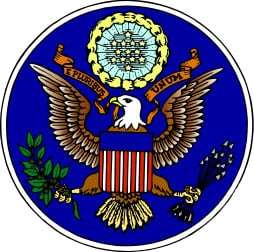The Volokh Conspiracy
Mostly law professors | Sometimes contrarian | Often libertarian | Always independent
Eighth-grader suspended for not removing patriotic T-shirt depicting a fallen soldier's rifle
Peter Holley (The Post's Morning Mix) reports:
[Alan Holmes, an eighth-grade student in Gresham, Ore.,] wanted to demonstrate that patriotism last week by wearing a T-shirt to school that included a design memorializing fallen soldiers and bearing the words "Standing for those who stood for us," according to KATU. Instead, the image on his shirt - boots, a helmet and a gun - got him suspended, the station reported.
Officials at Dexter McCarty Middle School asked Holmes to change his shirt, according to Fox affiliate KPTV. When he refused, the station reported, he was given an ultimatum: Remove the shirt or face suspension.
The T-shirt design appears, from the story and its accompanying image, to be this one:

The school dress code does prohibit "clothing with alcohol, tobacco, illicit drug and/or violence related references," and the depiction of a rifle surely is a "violence related reference." Indeed, any reference to the military could be seen as a "violence related reference." (We have a military chiefly to threaten violence, and use it if necessary.) Indeed, a T-shirt depicting the Oregon state seal would have a "violence related reference," in the form of the arrows that the eagle is holding:

And that eagle, of course, is borrowed from the Great Seal of the United States, the history of which, come to think of it, has quite a few "violence related references":

And the school's prohibition on the shirt appears to violate the First Amendment, at least unless there's some evidence that the T-shirt was actually likely to cause substantial disruption in the school. The mere fact that it displays a gun can't be reason to restrict the shirt, as Newsom ex rel. Newsom v. Albemarle County School Bd. (4th Cir. 2003) held in a similar situation:
[Tinker v. Des Moines Indep. School. Dist. (1969), the leading Supreme Court precedent on student speech in public K-12 schools,] "requires a specific and significant fear of disruption, not just some remote apprehension of disturbance." …
[N]onviolent and non-threatening images/messages related to weapons would fall squarely under Tinker's disruption standard ….
[The] Jouett Dress Code [which prohibits, in relevant part, "messages that relate to … weapons,"] can be understood as reaching lawful, nonviolent, and nonthreatening symbols of not only popular, but important organizations and ideals. For example, the State Seal of the Commonwealth of Virginia depicts a woman standing with one foot on the chest of a vanquished tyrant, holding a spear. The symbol obviously depicts a woman holding a weapon. Thus, under the … Jouett Dress Code, a student may not wear or carry any items bearing the State Seal of the Commonwealth of Virginia….
[The] Dress Code would apparently distinguish between a t-shirt bearing a peace sign and the message "No War" and one with a picture of an army tank in desert camouflage that urges support for our troops. Similarly, it would prevent a student from wearing a t-shirt bearing the insignia of many of the fighting units engaged in overseas operations in which parents or siblings may serve. Banning support for or affiliation with the myriad of organizations and institutions that include weapons (displayed in a nonviolent and nonthreatening manner) in their insignia can hardly be deemed reasonably related to the maintenance of a safe or distraction-free school. Finally, the quintessential political message the school here is trying to promote - "Guns and School Don't Mix" - would, under a reasonable interpretation, be prohibited on clothing under the … Dress Code.
Because there was no evidence presented at the preliminary injunction stage of the case demonstrating that clothing worn by students at Jouett containing messages related to weapons, nonviolent, nonthreatening, or otherwise, ever substantially disrupted school operations or interfered with the rights of others, the number of examples of the unnecessarily broad nature of the … Dress Code is practically limitless. After examining the record as it has developed through the preliminary injunction stage of the case, it is evident that the … Dress Code disfavors weapons, displayed in any manner and in any context, and potentially any messages about weapons. It excludes a broad range and scope of symbols, images, and political messages that are entirely legitimate and even laudatory. Under these circumstances, and in the absence of any cogent limiting construction of the … Dress Code, we are constrained to conclude that Newsom has demonstrated a strong likelihood of success on the merits on his overbreadth claim.
Nor does Morse v. Frederick (2007), which allowed a school to discipline a student for display a "BONG HiTS 4 JESUS" banner, change the analysis. The Supreme Court in Morse relied on its judgment (whether or not that judgment was correct) that (1) the banner lacked a political message and (2) promoted illegal drug use. Justice Alito's and Justice Kennedy's concurrence further stressed that those Justices "join[ed] the opinion of the Court on the understanding that (a) it goes no further than to hold that a public school may restrict speech that a reasonable observer would interpret as advocating illegal drug use and (b) it provides no support for any restriction of speech that can plausibly be interpreted as commenting on any political or social issue, including speech on issues such as 'the wisdom of the war on drugs or of legalizing marijuana for medicinal use.'"
The T-shirt here did comment on a political or social issue - the debt that the student thought we owed to our veterans. And the T-shirt certainly did not promote illegal use of weapons. Nothing in Morse suggests that a school may ban all images of weapons, including those in political or social commentary, any more than it can ban black armbands protesting the war (the speech involved in Tinker).
For more on a similar incident from New York in 2014, see this story.



Show Comments (0)